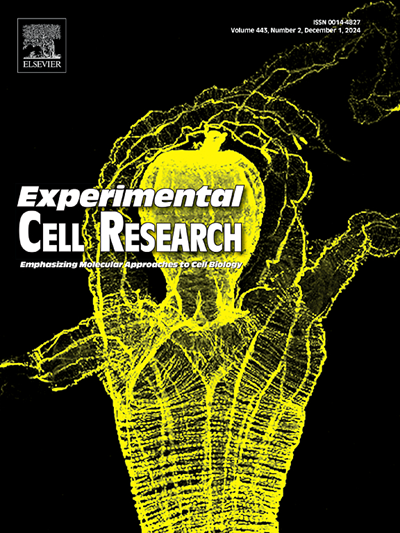通过蛋白质组分析发现ALK抑制剂耐药肺癌细胞中的新分子靶点--超氧化物歧化酶1。
IF 3.3
3区 生物学
Q3 CELL BIOLOGY
引用次数: 0
摘要
背景:据我们所知,目前还没有关于通过蛋白质组学分析鉴定参与无性淋巴瘤激酶(ALK)抑制剂耐药性的未知蛋白质的报道。在这项研究中,我们通过蛋白质组学分析研究了参与ALK抑制剂阿来替尼耐药性的蛋白质以及克服耐药性的可能性:方法:采用ALK阳性肺腺癌细胞株(ABC-11)和相应的阿来替尼耐药细胞株(ABC-11/CHR2)。进行二维差异凝胶电泳(2D DIGE);使用 DeCyder TM2D 7.0 扫描染色凝胶并分析斑点。使用 UltrafleXtreme 矩阵辅助激光解吸电离-串联飞行时间质谱(MALDI-TOF/TOF)系统进行质谱分析。在进行 MS/MS 分析时,样品被置于 AnchorChipTM 600 TF 平板上。在重扫描正向模式下获得的肽段质量的 m/z 为 400-6,000。根据 NCBI 蛋白质数据库搜索 MS/MS 数据。使用 MTT 法测量生长抑制作用。根据中位效应分析计算等全息图和组合指数。使用超氧化物歧化酶(SOD)1、MET、ERK、PARP、AKT 和 BRCA1 等抗体进行了 Western 印迹分析:ABC-11和ABC-11/CHR2的二维DIGE在约2000个点上显示出不同的表达水平。在抗性菌株的高表达点中发现了 SOD。siSOD1 增强了阿来替尼的生长抑制作用,提高了裂解 PARP 水平,降低了 pERK、pAKT 和 BRCA1 水平。此外,SOD1抑制剂LCS-1和阿来替尼联合使用能协同抑制ABC-11/CHR2的生长,但不能抑制ABC-11的生长:结论:SOD1过表达被认为是阿来替尼耐药的一个机制,这表明使用SOD1抑制剂有可能克服耐药性。本文章由计算机程序翻译,如有差异,请以英文原文为准。
A novel molecular target, superoxide dismutase 1, in ALK inhibitor-resistant lung cancer cells, detected through proteomic analysis
Backgrounds
To the best of our knowledge, there are no reports of proteomic analysis for the identification of unknown proteins involved in resistance to anaplastic lymphoma kinase (ALK) inhibitors. In this study, we investigated the proteins involved in resistance to alectinib, a representative ALK inhibitor, through proteomic analysis and the possibility of overcoming resistance.
Methods
An ALK-positive lung adenocarcinoma cell line (ABC-11) and the corresponding alectinib-resistant cell line (ABC-11/CHR2) were used. Two-dimensional difference gel electrophoresis (2D DIGE) was performed; the stained gel was scanned and the spots were analyzed using DeCyder TM2D 7.0. Mass spectrometry (MS) with the UltrafleXtreme matrix-assisted laser desorption ionization-tandem time-of-flight (MALDI-TOF/TOF) MS system was performed. For the MS/MS analysis, the samples were spotted on an AnchorChipTM 600 TF plate. The peptide masses obtained in the reflector positive mode were acquired at m/z of 400−6000. MS/MS data were searched against the NCBI protein databases. Growth inhibition was measured using an MTT assay. The isobologram and combination index were calculated based on the median-effect analysis. Western blotting was performed using antibodies, including superoxide dismutase (SOD) 1, MET, ERK, PARP, AKT, and BRCA1.
Results
The 2D DIGE for ABC-11 and ABC-11/CHR2 showed different expression levels in about 2000 spots. SOD was identified from spots highly expressed in resistant strains. Western blotting also confirmed SOD1 overexpression in ABC-11/CHR2. siSOD1 enhanced the growth inhibitory effects of alectinib, increased cleaved PARP levels, and decreased pERK, pAKT, and BRCA1 levels with a combination of alectinib. In addition, the combination of LCS-1, an SOD1 inhibitor, and alectinib synergistically suppressed the growth in ABC-11/CHR2, but not in ABC-11.
Conclusions
SOD1 overexpression is thought to be a mechanism for alectinib resistance, suggesting the possibility of overcoming resistance using SOD1 inhibitors.
求助全文
通过发布文献求助,成功后即可免费获取论文全文。
去求助
来源期刊

Experimental cell research
医学-细胞生物学
CiteScore
7.20
自引率
0.00%
发文量
295
审稿时长
30 days
期刊介绍:
Our scope includes but is not limited to areas such as: Chromosome biology; Chromatin and epigenetics; DNA repair; Gene regulation; Nuclear import-export; RNA processing; Non-coding RNAs; Organelle biology; The cytoskeleton; Intracellular trafficking; Cell-cell and cell-matrix interactions; Cell motility and migration; Cell proliferation; Cellular differentiation; Signal transduction; Programmed cell death.
 求助内容:
求助内容: 应助结果提醒方式:
应助结果提醒方式:


